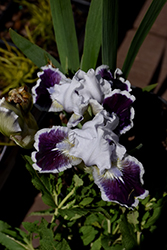>> Home
Height: 13 inches
Spacing: 18 inches
Sunlight:
![]()
![]()
Hardiness Zone: 4a
Group/Class: Standard Dwarf Bearded
Description:
A stunning mid spring bloomer, perfect for adding interest to garden beds, borders or rock gardens; silver-blue blooms with deep indigo falls and ruffled silver-blue edges; dwarf bearded variety
Ornamental Features
Puddy Tat Iris has masses of beautiful silvery blue flag-like flowers with a indigo beard at the ends of the stems in mid spring, which are most effective when planted in groupings. Its sword-like leaves remain green in colour throughout the season.
Landscape Attributes
Puddy Tat Iris is an herbaceous perennial with an upright spreading habit of growth. Its relatively fine texture sets it apart from other garden plants with less refined foliage.
This plant will require occasional maintenance and upkeep, and should be cut back in late fall in preparation for winter. Deer don't particularly care for this plant and will usually leave it alone in favor of tastier treats. Gardeners should be aware of the following characteristic(s) that may warrant special consideration;
- Spreading
- Insects
Puddy Tat Iris is recommended for the following landscape applications;
- Mass Planting
- General Garden Use
- Groundcover
- Naturalizing And Woodland Gardens
Planting & Growing
Puddy Tat Iris will grow to be about 10 inches tall at maturity, with a spread of 24 inches. When grown in masses or used as a bedding plant, individual plants should be spaced approximately 18 inches apart. Its foliage tends to remain low and dense right to the ground. It grows at a medium rate, and under ideal conditions can be expected to live for approximately 10 years. As an herbaceous perennial, this plant will usually die back to the crown each winter, and will regrow from the base each spring. Be careful not to disturb the crown in late winter when it may not be readily seen!
This plant does best in full sun to partial shade. It requires an evenly moist well-drained soil for optimal growth, but will die in standing water. This plant should not require much in the way of fertilizing once established, although it may appreciate a shot of general-purpose fertilizer from time to time early in the growing season. It is not particular as to soil type or pH. It is somewhat tolerant of urban pollution. This particular variety is an interspecific hybrid. It can be propagated by division; however, as a cultivated variety, be aware that it may be subject to certain restrictions or prohibitions on propagation.
